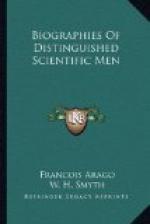[19] It would be more correct to say four times as much light.—Translator.
[20] On comparing the Cassegrain telescopes with a small convex mirror, to the Gregorian telescopes with a small concave mirror, Captain Kater found that the former, in which the luminous rays do not cross each other before falling on the small mirror, possess, as to intensity, a marked advantage over the latter, in which this crossing takes place.
[21] In the selection of i Bootis as a test, Arago has taken the precaution of giving its corresponding denomination in other catalogues, and Bailey appends the following note, No. 2062, to 44 Bootis. “In the British Catalogue this star is not denoted by any letter: but Bayer calls it i, and on referring to the earliest MS. Catalogue in MSS. vol. xxv., I find it is there so designated; I have therefore restored the letter.” (See Bailey’s Edition of Flamsteed’s British Catalogue of Stars, 1835.) The distance between the two members of this double star is 3".7 and position 23 deg..5. See “Bedford Cycle.”—Translator.
LABOURS IN SIDEREAL ASTRONOMY.
The curious phenomenon of a periodical change of intensity in certain stars, very early excited a keen attention in Herschel. The first memoir by that illustrious observer presented to the Royal Society of London and inserted in the Philosophical Transactions treats precisely of the changes of intensity of the star o in the neck of the Whale.
This memoir was still dated from Bath, May, 1780. Eleven years after, in the month of December, 1791, Herschel communicated a second time to that celebrated English Society the remarks that he had made by sometimes directing his telescopes to the mysterious star. At both those epochs the observer’s attention was chiefly applied to the absolute values of the maxima and minima of intensity.
The changeable star in the Whale was not the only periodical star with which Herschel occupied himself. His observations of 1795 and of 1796 proved that a Herculis also belongs to the category of variable stars, and that the time requisite for the accomplishment of all the changes of intensity, and for the star’s return to any given state, was sixty days and a quarter. When Herschel obtained this result, about ten changeable stars were already known; but they were all either of very long or very short periods. The illustrious astronomer considered that, by introducing between two groups that exhibited very short and very long periods, a star of somewhat intermediate conditions,—for instance, one requiring sixty days to accomplish all its variations of intensity,—he had advanced the theory of these phenomena by an essential step; the theory at least that attributes every thing to a movement of rotation round their centres which the stars may undergo.




